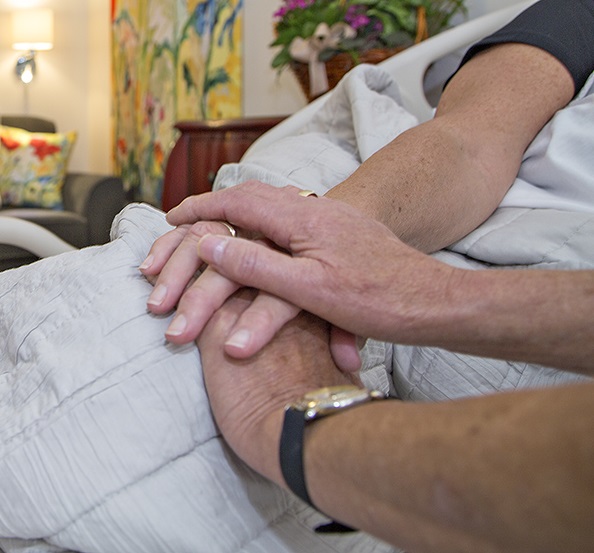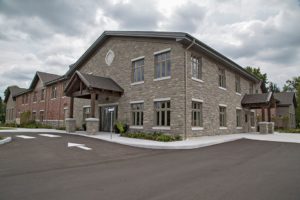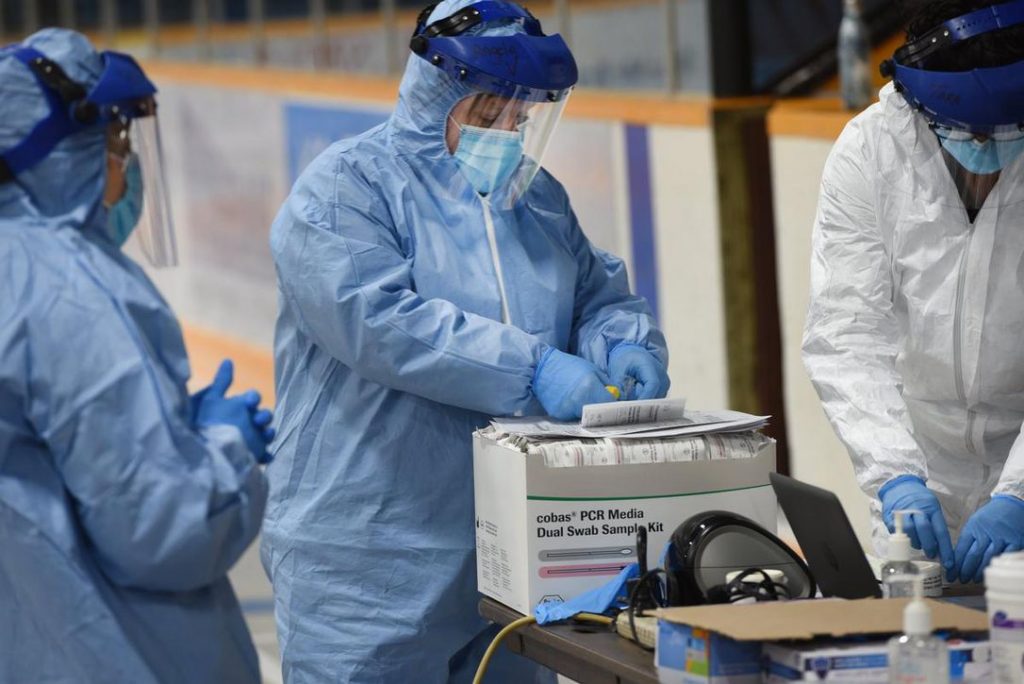Susan Gamble, The Brantford Expositor
Published on: May 4, 2020
The physical distancing requirements aimed at stopping the spread of COVID-19 have meant changes in how people can say goodbye to their loved ones at the Stedman Community Hospice,
“Our rules have changed but our overall objective is still the same – to ensure the best possible hospice experience for the patient, family and their visitors,” said executive director Elaine Calvert.
She said patients and their family members understand the new guidelines before admission.
“Everyone is provided with the information prior to an admission decision so they can understand the rules before they come. We make sure there’s a full awareness.”
The biggest change is that the hospice, with few exceptions, permits only one designated family member to be with a patient during the admission phase and one family member at a time when death is imminent. It’s similar to rules at Brantford General Hospital, where visitors are barred except for specific compassionate grounds to see dying patients.
But the design of the hospice’s Hankinson House, which opened in 2014, makes it accessible for “window visits,” said Calvert. Each of the 10 rooms that house patients has a large low window.
“They’re very popular and we are so fortunate to have a building that can accommodate privacy.”
A large deck soon will accommodate outdoors visits, too.
Hankinson House also is outfitted with technology that allows people to visit using FaceTime and Skype. And staff is on hand to support phone calls and virtual visits.
“We’re seeing every kind of device and all kinds of virtual presence you can imagine,” Calvert said. “Sometimes it even means combining a phone call with a window visit.”
Such visits are planned and co-ordinated with the staff.
“We’ve had to get very creative,” said Calvert.
“These are such unusual times but I could not be more proud of our staff. The level of co-ordination and commitment they demonstrate each day to ensure the patients and their families are supported is amazing.”
All visitors to the hospice are screened and staff wear masks and follow physical distancing guidelines set by the province.
Calvert said the hospice misses its volunteers who helped in the kitchen and with maintaining gardens.
“They are such an important part of the team and we very much look forward to welcoming them back.”
Despite the new rules, no one has turned down admission to Hankinson House, said David Wormald, president of the St. Joseph’s Lifecare Centre, which runs the hospice, along with the adjacent long-term care residence..
There have been no confirmed cases of COVID-19 in residents of either the hospice or at long-term residence.
A COVID-19 outbreak was declared at St. Joseph’s on April 2 after a staff member at the long-term residence tested positive for the virus. That outbreak was declared over on April 12 but a second staff member tested positive April 23. But subsequent extensive testing has yielded no further positive results.
“We took a very proactive approach early on and our staff is absolutely dedicated to our hospice and long-term residents,” said Wormald. “They’re showing such commitment and living our mission of compassion, courage and care.”
He said St. Joseph’s considers it essential to protect its staff, residents and their family members.
“These are quite extraordinary times but we continue to be vigilant.”
Sunday was to be date for the 16th annual Hike for Hospice, which has been postponed due to the virus. The hospice has an annual operating budget of about $3 million, with about half funded by community donations through the St. Joseph’s Lifecare Foundation. Last year’s hike brought in just over $338,000.
The hike was also meant to mark the official retirement of Olga Consorti from the president and CEO role she has held with the foundation for the past 30 years. She has agreed to stay in the role until at least the end of June.
SGamble@postmedia.com
@EXPSGamble
By Katrina Clarke Spectator Reporter
Mon., April 20, 2020
A new pilot project will see some 3,000 asymptomatic residents and staff at Hamilton and area care settings tested for COVID-19.
On Monday, St. Joseph’s Health System and Niagara Health announced a pilot project is underway to test all asymptomatic patients, residents and some staff in its long-term care homes, retirement homes and congregate settings, such as hospices.
The goal is to gain a better understanding of how the virus spreads, how can spread be prevented and what testing strategies are most effective when the subjects are concentrated in one place, said Dr. Jack Gauldie, vice-president of research at St. Joseph’s Healthcare Hamilton.
“Right now, we stand outside long-term care homes and we don’t know how many people are carriers in there, how many people are affected,” Gauldie said. “The earlier you catch something, the earlier you can do something about it.”
The announcement comes a week after the province said more people in long-term care settings would be tested for the virus. Testing of all asymptomatic staff and residents at “select homes” would take place, said Minister of Long-Term Care Merrilee Fullerton.
Dr. Tom Stewart, CEO of St. Joseph’s Health System, said those involved with the pilot project wanted to be ahead of the curve.
“Let’s get an understanding of are there patients in there that are asymptomatic that could be the cause of a future outbreak?” Stewart said. “Let’s collect more information.”
Testing is already underway.
According to a release, 111 long-term care residents have so far been tested for COVID-19 “whether they had symptoms or not” as part of the pilot. All tests were negative. Staff have the option of being tested.
All 3,000 tests are expected to be carried out this week, Stewart said.
Facilities included in the pilot project include St. Joseph’s Villa in Dundas, St. Joseph’s Health Centre in Guelph, St. Joseph’s Lifecare Centre Brantford and Stedman Community Hospice in Brantford, St. Joseph’s Home Care First Place retirement living in Hamilton and the Niagara Health long-term care unit in Welland.
Hamilton public health, meanwhile, has carried out “mass testing” of staff and residents at seniors’ care homes, said Dr. Bart Harvey, Hamilton’s associate medical officer of health, on Monday.
Mass testing sites include Cardinal Retirement Residence, Chartwell Deerview Crossing Retirement Residence and Kingsberry Retirement Residence. Outbreaks are ongoing at each location.
So far, 45 residents and 17 staff at Cardinal have tested positive. Six died. One staff member at Chartwell Deerview tested positive and three Kingsberry residents have tested positive.
Harvey said mass testing gives public health “a much better idea of what efforts are needed and what strategies are needed to curb any further transmission.”
Long-term care homes across the country have been the epicentre of deadly COVID-19 outbreaks for more than a month. Half of Canada’s COVID-19 deaths stem from long-term care homes, said Dr. Theresa Tam, the country’s chief public health officer, last week.
As of Monday, 16 people in Hamilton have died from COVID. All but four were residents of one of two long-term care homes — Heritage Green and Cardinal — or Emmanuel House Hospice.
The pilot project is a joint effort and includes researchers at the Research Institute of St. Joe’s Hamilton, McMaster University, Hamilton Regional Laboratory Medicine Program, Guelph Family Health Team and GTA public health units.
Gauldie said once the project is complete, experts will analyze data, looking at how to minimize glitches, maximize efficiency and improve accuracy.
“We need to see how to do it correctly,” he said.
Katrina Clarke is a Hamilton-based reporter at The Spectator. Reach her via email: katrinaclarke@thespec.com



